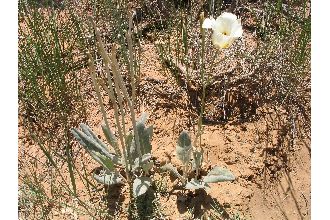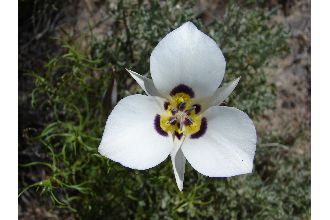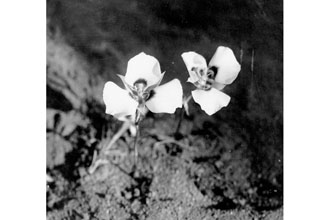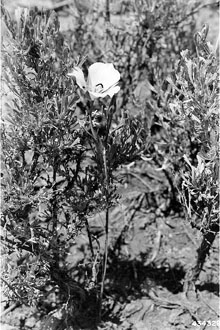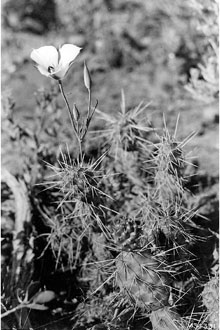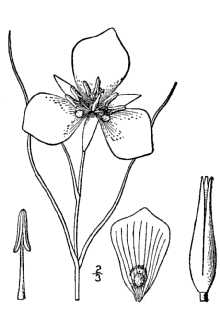Sego Lily
Scientific Name: Calochortus nuttallii Torr. & A. Gray
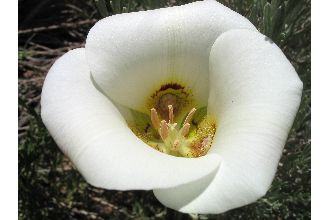
| General Information | |
|---|---|
| Usda Symbol | CANU3 |
| Group | Monocot |
| Life Cycle | Perennial |
| Growth Habits | Forb/herb |
| Native Locations | CANU3 |
Plant Guide
Description
General: Lily Family (Liliaceae). Sego lily is a perennial native forb that grows 10-20 inches high. It grows from a small egg-shaped bulb, 3/8 to 1 inch in diameter, with a membranous coat. The stem is slender, usually unbranched, and bears 2 to 4 simple, linear, narrow leaves, 7-10 inches long. Flowers are very showy, tulip-like, about 3 inches across with 3 petals and 3 sepals. Petals are white, occasionally tinged with lilac or pink, and yellow near the base. There are glands at the base of each petal which are bearded with slender hairs. There is a brownish-purple spot or band above each gland. Sego lilies bloom May-July depending on elevation, and the above ground portion of the plant dries up shortly after blooming. The fruit is an erect, 3-sectioned capsule that splits open to reveal yellowish flat seeds (Hitchcock & Cronquist, 1973; Cronquist et al., 1977). Distribution: Sego lily occurs in high desert country throughout the Rocky Mountain states, the Great Basin, and the western Great Plains (USDA-NRCS, 2021). For current distribution, consult the Plant Profile page for this species on the PLANTS Web site. Habitat: Sego lily is found in brushy or grassy slopes in dry areas, typically within open sagebrush country and open ponderosa pine or pinyon-juniper forests. Its elevation range is from 2,300 to 10,000 ft above sea level.
Adaptation
Sego lily is adapted to dry, well-drained soils. It blooms early in the season and then the aboveground parts dry up, avoiding high summer temperatures and drought. Associated plants include sagebrush (the Artemisia tridentata complex), death camas (Zigadenus spp.), lupines (Lupinus spp.), pinyon pine (Pinus edulis, Pinus monophylla), juniper (Juniperus spp.), and ponderosa pine (Pinus ponderosa).
Uses
Wildlife: The bulbs are eaten by rodents. A similar species, sagebrush mariposa lily (C. macrocarpus) is a documented food source for juvenile sage grouse (Klebenow & Gray, 1968); the authors use “sego lily” as the common name of C. macrocarpus. Warning: Death camas (Zigadenus sp.) is toxic and can be confused with sego lily in the absence of flowers. Be sure of your identification of sego lily bulbs before eating them.
Ethnobotany
The English word “sego” comes from similar words for the plant in various Numic (Great Basin) languages. Many Native American tribes around the Great Basin and surrounding areas including the Washoe, Owens Valley Paiute, Western Natural Resources Conservation Service Plant Guide Sego lily. Photo by Cassondra Skinner, hosted by the USDA-NRCS PLANTS Database. Sego lily. Photo by Mary Wolf Shoshone, Northern Shoshone, Eastern Shoshone, Goshute (Gosiute), Utah Southern Paiute, and Northern Ute harvested and ate the pleasant-tasting bulbs of sego lily (Fowler, 1986). Sego lily bulbs were a common food in the Northern Paiute, Northern Shoshone, and Bannock culture areas of Idaho (Steward, 1938). The Northern Paiute dug the bulbs in the spring and ate them raw or roasted. Surplus bulbs were cached in pits lined with cattail leaves or grass (Fowler, 1990). Sego lily bulbs were also dried for storage. The dried bulbs were ground and cooked into soup or porridge (Fowler, 1989). Goshute (Gosiute) and Ute people of Utah and Nevada dried the bulbs to preserve them for winter use (Chamberlin, 1909; Chamberlin, 1911). The Navajo also ate sego lily bulbs and relied on them in times of food scarcity (Lynch, 1986). The Havasupai of the Grand Canyon harvested the bulbs and ate them with bread (Weber & Seaman, 1985). Various other Calochortus species were used by Native Americans as well. Native Americans taught Mormon pioneers to use the bulb for food during times of food shortage. This led to the designation of sego lily as the official state flower of Utah (USU, 2021).
Status
Threatened or Endangered: No Wetland Indicator: UPL Weedy or Invasive: No Please consult the PLANTS Web site (http://plants,usda, Use soil moisture sensors to measure the soil moisture of Sego Lily.,gov/) and your state’s Department of Natural Resources for this plant’s current status (e,g,, threatened or endangered species, state noxious status, and wetland indicator values),
Planting Guidelines
Seed requires cold-moist stratification to germinate. Blanke et al. (2011) planted seeds in a flat which was placed outdoors over winter (Colorado). The seeds underwent natural stratification and began to germinate in late May. The Aberdeen Plant Materials Center used a similar technique, planting seeds in peat pellets left outside for 90 days (November-February). Pellets were then brought into the greenhouse (75-85 oC), where seeds began to germinate. Seeds can also be cold-moist stratified artificially (40-60 days at 36 oC) and then transplanted into containers (Blanke et al., 2011).
Management
Germinating seedlings should be kept moist. Plants should be grown in soil that is dry from mid-summer to late fall (wildflower.org, 2008). Bulbs reach maturity in 3 to 5 years (wildflower.org, 2008).
Pests and Potential Problems
Protect the growing bulbs from burrowing rodents such as gophers.
Environmental Concerns
Concerns
Concerns
None known.
Seeds and Plant Production
Plant Production
Plant Production
Sego lily reproduces by seed. Collect seed when the capsules are dry and beginning to open. There are approximately 190,000 seeds/lb (Hassell et al., 1996). Sego lily is extremely difficult to grow from transplanted bulbs. Collected bulbs are not likely to survive transplanting (Hitchcock & Cronquist, 1973). Cultivars, Improved, and Selected Materials There are currently no selected materials of Calochortus nuttallii. Other species of Calochortus are available on the commercial market.
Literature Cited
Blanke, T., & Woodruff, H. (2011). Propagation protocol for production of Calochortus nuttallii plants. Upper Colorado Environmental Plant Center Meeker, Colorado. In: Native Plant Network. US Department of Agriculture, Forest Service, National Center for Reforestation, Nurseries, and Genetic Resources http://NativePlantNetwork.org Chamberlin, R.V. (1909). Some Plant Names of the Ute Indians. American Anthropologist (11):27-40. Sego lily seedlings in greenhouse. Note seed coats still attached to cotyledons. Photo by Mary Wolf.
Conservation
Service. Portland, OR. Hitchcock, C.L. and Cronquist, A. (1973). Flora of the Pacific Northwest. An Illustrated Manual. University of Washington Press. Klebenow, D. A., & Gray, G. M. (1968). Food habits of juvenile sage grouse. Journal of Range Management, 21(2), 80-83 Lynch, R.H. (1986). Cookbook: Chiyaan Ulini Binaaltsoos. First Edition. Navajo Curriculum Center, Rough Rock Demonstration School. Steward, J.H. (1938). Basin-Plateau Aboriginal Groups. Bulletin 120. Bureau of American Ethnology, Smithsonian Institution. USDA-NRCS. (2021). The PLANTS Database. National Plant Data Team. Greensboro, NC. http://plants.usda.gov USU. (2021). Sego lily. Range Plants of Utah. Utah State University Extension. https://extension.usu.edu/rangeplants/forbsherbaceous/sego-lily Weber, S.A., & Seaman, P.D. (1985). Havasupai habitat: A.F. Whiting’s ethnography of a traditional Indian culture. University of Arizona Press. https://doi.org/10.2307/j.ctvxhrj5x Wildflower.org. (2008). Calochortus nuttallii. Plant Database. Lady Bird Johnson Wildflower Center. https://www.wildflower.org/plants/result.php?id_plant=CANU3 Citation Wolf, M., & Tilley, D. (2021). Plant Guide for sego lily (Calochortus nuttallii). USDA-Natural Resources Conservation Service, Aberdeen Plant Materials Center. Aberdeen, ID. Published June 2021 For more information about this and other plants, please contact your local NRCS field office or Conservation District at http://www.nrcs.usda.gov/ and visit the PLANTS Web site at http://plants.usda.gov/ or the Plant Materials Program web site: http://plant-materials.nrcs.usda.gov. PLANTS is not responsible for the content or availability of other Web sites. In accordance with Federal civil rights law and U.S. Department of Agriculture (USDA) civil rights regulations and policies, the USDA, its Agencies, offices, and employees, and institutions participating in or administering USDA programs are prohibited from discriminating based on race, color, national origin, religion, sex, gender identity (including gender expression), sexual orientation, disability, age, marital status, family/parental status, income derived from a public assistance program, political beliefs, or reprisal or retaliation for prior civil rights activity, in any program or activity conducted or funded by USDA (not all bases apply to all programs). Remedies and complaint filing deadlines vary by program or incident. Persons with disabilities who require alternative means of communication for program information (e.g., Braille, large print, audiotape, American Sign Language, etc.) should contact the responsible Agency or USDA's TARGET Center at (202) 720-2600 (voice and TTY) or contact USDA through the Federal Relay Service at (800) 877-8339. Additionally, program information may be made available in languages other than English. To file a program discrimination complaint, complete the USDA Program Discrimination Complaint Form, AD-3027, found online at How to File a Program Discrimination Complaint and at any USDA office or write a letter addressed to USDA and provide in the letter all of the information requested in the form. To request a copy of the complaint form, call (866) 632-9992. Submit your completed form or letter to USDA by: (1) mail: U.S. Department of Agriculture, Office of the Assistant Secretary for Civil Rights, 1400 Independence Avenue, SW, Washington, D.C. 20250-9410; (2) fax: (202) 690-7442; or (3) email: program.intake@usda.gov. USDA is an equal opportunity provider, employer, and lender.

